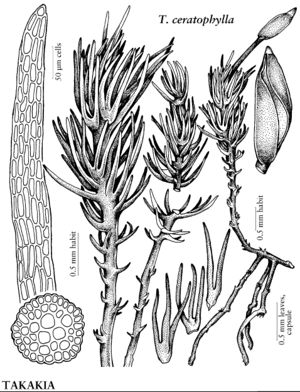Takakiaceae
Stems erect, arising sympodially from creeping pale or white stolons bearing clusters of beaked slime cells, rhizoids absent, stem in cross-section differentiated into outer layer of smaller, thick-walled cells and cortex of larger thin-walled cells, sometimes with small central cells, these often with trigones, outer cells with simple oil droplets. Leaves typically 3-ranked, terete, forked, of (1–) 2–4 terete segments, segments sometimes connate at base, in cross-section of 3–5 cells, one or more larger central cells surrounded by smaller cells, oil droplets present in all cells, 2-celled slime hairs with enlarged apical cell present in axils of leaves. Specialized asexual reproduction by caducous leaves or stems. Sexual condition dioicous, gametangia naked. Seta with foot, persistent, elongating prior to capsule maturation. Capsule erect, symmetric, well-defined neck region absent, stomates absent, dextrorsely spiralled at maturity, columella ephemeral, basifixed, not penetrating the archesporial tissue, peristome absent, dehiscence by longitudinal helical slit. Calyptra fugacious to rarely persistent, typically mitrate. Spores 3-radiate, slightly roughened to papillose.
Distribution
North America, se Asia (including Borneo)
Discussion
Genus 1, species 2 (2 in the flora).
Takakiaceae are plants of cool, cold-temperate to arctic-alpine oceanic climates. They were first collected in the Himalayas by J. D. Hooker and placed in the hepatic genus Lepidozia as L. ceratophylla by W. Mitten. The consensus has been that it was a highly unusual liverwort with affinity to the Calobryales. Distinctive features include erect shoots arising from a stolon, terete leaves, sometimes fused at or near the base and thus of 2–4 segments, naked lateral gametangia, slime cells, oil droplets, and chromosome numbers of n = 4 or 5. In 1993 sporophytes and antheridia were discovered in a population from Atka Island of the Aleutian Islands (D. K. Smith and P. G. Davison 1993). The sporophyte exhibits its affinity with the mosses, and is similar in some respects to sporophytes of the Andreaeopsida, by the columella, persistent seta, capsule that matures after seta elongation, dehiscence by a diagonal slit, and absence of elaters. R. M. Schuster (1997) suggested that gametophytically Takakia is more like a liverwort, and sporophytically more like a moss. The Japanese common name is perhaps most telling, literally translated as “puzzling moss.”

